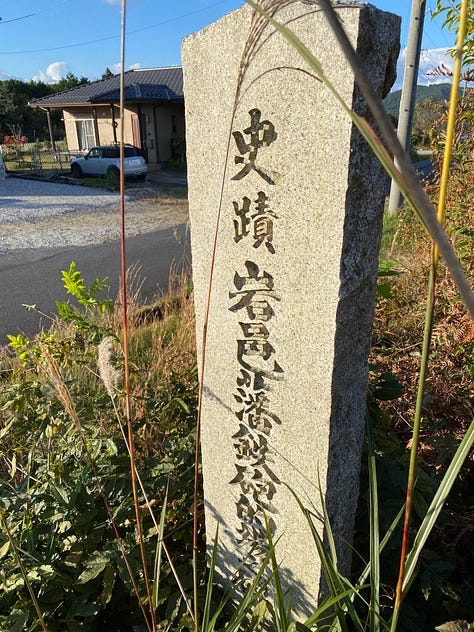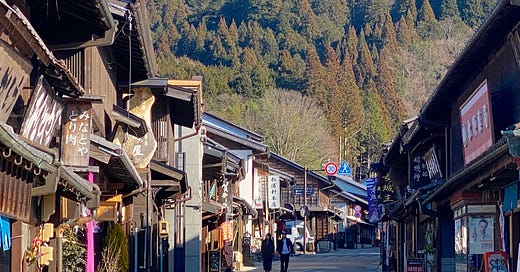Apart from Kyoto, most of Japan’s major cities began as castle towns. Tokyo (Edo), Osaka Nagoya, Hiroshima, Kumamoto,…all are castle towns. Samurai would construct a castle, and people of all classes, merchants, artisans and peasants would gather around it forming urban centres to cater for the needs of the samurai garrisons and others in these new communities.
Naturally, while the castles contained all manner of defensive capabilities to thwart enemy advances and attack, in fact, so too did the castle towns. They were more than just residential and economic centers; they were strategically functional.


In fact, the castle towns served as an early and important line of defense, and so their design reflected this. Unfortunately, as Japan modernized, many of the security and deterrent features found within the castle towns were abandoned, destroyed, or altered to better suit modern needs, and altogether forgotten.
Iwamura in Gifu Prefecture’s Ena region is one of those castle towns that retains many of the original defensive features of the old days. Iwamura Castle is one of Japan’s Top Three Mountain Castles, along with Takatori and Bitchu Matsuyama Castles, and Iwamura’s castle town is arguably among the top three best preserved too. Entering the old houses, one will notice spear racks above the doorframes, and in some cases, spears still displayed and light jingasa helmets at the ready. An old inn in the former ashigaru quarters is now a guest house for travelers. Everywhere are reminders of the towns martial past.
Besides the Edo period townscape of houses, shops, and the impressive castle ruins, Iwamura still retains the original gunsmith forge where matchlock guns for local use were produced! The extant two-story gun production facility was originally a forge for the making of swords, but later switched to the making of bores, firing mechanisms, stocks and all parts of the much-coveted matchlock guns. On the topic of firearms, there is a large earthen mound remaining to the north of the town that was once part of a test battery for guns and cannons in the closing years of the Edo period. A small stone marker explains the site.




The town layout of Iwamura itself is worthy of note. North of the narrow river running through the town’s center and forming a natural moat were the samurai quarters. To the south were the merchant quarters. This is also part of the security measures built into the town.
The narrow main road of Iwamura is constructed along an upward slope, and curves slightly to the right. This was all part of the plan to protect the castle. The slope would slow attackers, and the right-hand curve makes it physically more difficult to advance, particularly as most samurai weapons, spears, bows and matchlock guns, were held left hand forward. This also makes it easier for the defenders as the enemy would approach from their left as they came up the narrow streets. The streets also feature sudden right-hand cranks, designed to slow the momentum of an attacking force, causing a bottleneck and points in which to counter-attack. One such place in the center of Iwamura is the Masugata. A masu is a square, open topped wooden measuring box, used for measuring serves of rice or beans. Smaller masu are used as sake serving and drinking cups. Like these serving boxes, masugata are square or rectangular gated courtyards located along a route, or at castle entrances, surrounded on all four sides by high walled defensive attack points. Masugata are best remembered by calling them a death box. Anyone entering such a space is bound to be trapped and killed! Another point is a small street coming off at an angle from the main road, but hidden from view from potential attackers. Units of defenders could wait here and counter-attack the invading forces from behind if need be.
Iwamura, just two hours by train or car from Nagoya City is a little known, mostly undiscovered historical area, retaining much of the old Japan character. Its tranquil streets hide many more features designed to act as a front-line defense for Iwamura Castle.
Iwamura Castle
Built atop a 721m peak as protection for the south-eastern areas of Mino Province, Iwamura Castle, also known as Kirigajo, (Castle of the Mist) is considered one of the top three yamajiro, mountaintop castles in Japan. Iwamura Castle located above the township of Iwamura, (Ena District, Gifu Prefecture) was first established around 1185 by a retainer of the first ever Shogun, Minamoto no Yoritomo, Kato Kagekado, whose descendants, the Toyama clan, ruled the castle from the 13th to 16th centuries. The last of the Toyama lords, Toyama Kageto, was allied with Oda Nobunaga. The castle saw a great deal of action over the years. (Later next month I’ll be telling you another, quite shocking, but true story from this remarkable castle’s history.)

Parts of the lower section of Iwamura castle have been reconstructed, including the Taiko Yagura, drum tower, gates and a few walls. These now surround the small museum dedicated to the history of the castle that provides visitors with a glimpse of the past. Some former samurai homes are open to the public along the main street of the castle town below the mountain. Reconstructed turrets and gates, and the magnificent stone walls are all that remain at the lower section of the castle where the lords’ residences once stood. Many visitors see these stone walls and reconstructed structures around the museum area and leave thinking that they’ve seen the castle site! This is just the residential part of the castle, the full military installation was at the top of the mountain. Here one can see some remarkable stone work from the original castle remaining. The bulk of what remains is mostly late Sengoku, early Edo period work, but this too is most impactful.
Even so, one can only marvel at these sturdy stone walls. Each rock was so carefully fitted together without use of modern day trucks, cranes or cutting equipment, leaving us to imagine the scale and grandeur of this fine mountain top castle, and the power of the samurai lords who built it.








Another great little article. It underscores to those actually training in old martial traditions how what we do within the dojo is only a portion of what was needed to be known to survive.